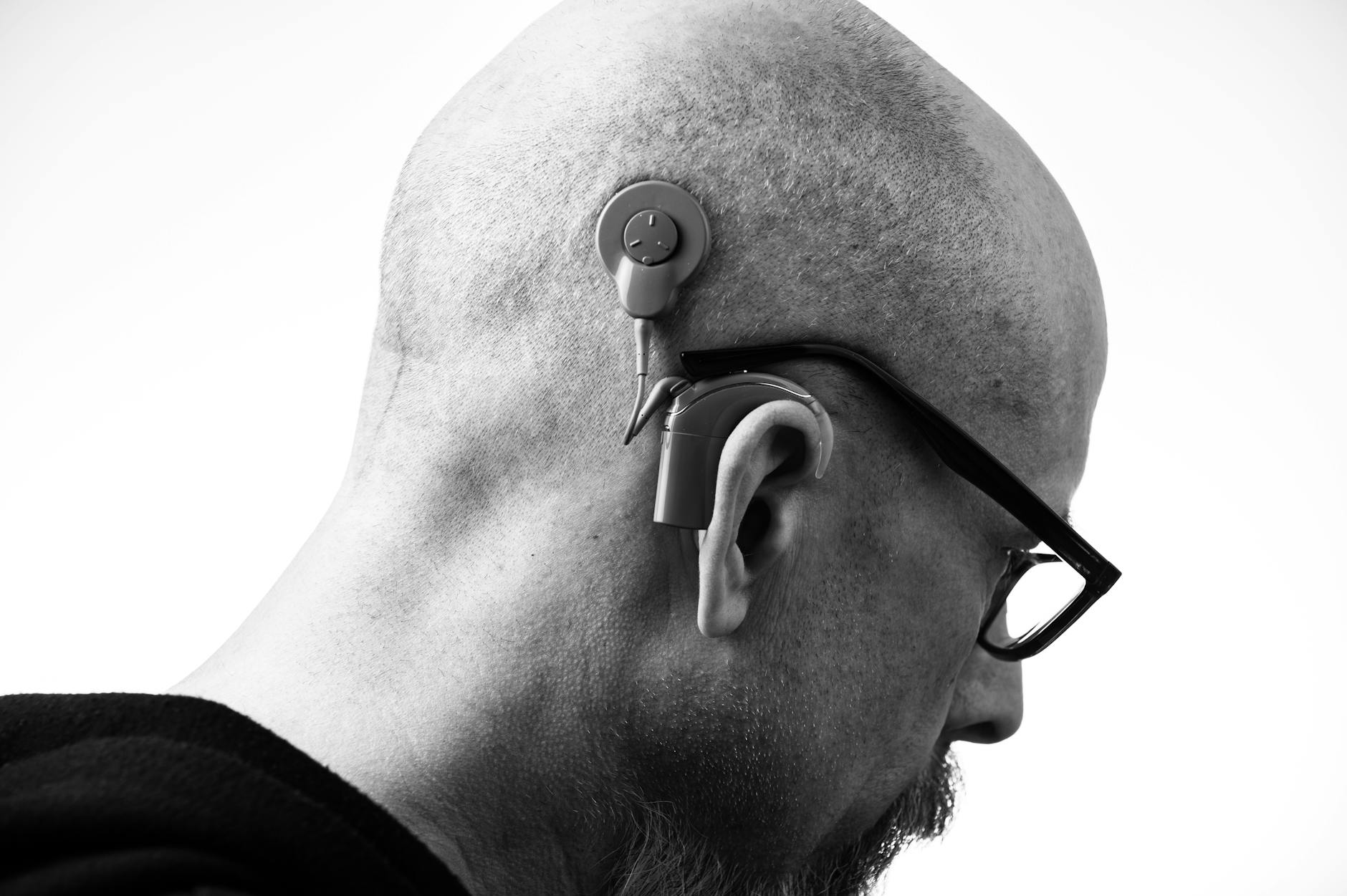“I hear you talking—I just can’t make out the words.” If that sounds familiar, you’re not imagining it. Loudness and clarity are not the same thing. Here’s how to understand the difference and what you can do about it.
Why Hearing Can Feel Fine—Until There’s Noise
Most of us think of hearing tests as the beeps in a quiet room. That test—your audiogram—shows how soft a sound needs to be before you detect it. Important? Absolutely. But real life isn’t quiet. Restaurants, meetings, open offices, family gatherings—these settings challenge your brain to separate speech from a sea of other sounds.
That’s where speech clarity comes in. You might hear that someone is talking, but your brain can’t fill in the exact consonants and transitions that make words distinct. The result: guessing, asking for repeats, and feeling mentally drained by the end of the day.
Meet the Two Scores That Explain Everyday Struggle
1) Word Recognition Score (WRS)
Your word recognition score (sometimes called speech discrimination) measures how accurately you repeat single words played at a comfortable loudness in a quiet room. Scores typically range from 0% to 100% for each ear.
Key points:
- A high WRS in quiet suggests you can identify speech clearly when it’s loud enough and there’s no competing noise.
- A reduced WRS, even in quiet, often means clarity issues that volume alone won’t fix. Some people describe this as “muffled” or “tinny” speech.
- WRS can vary by ear; you might hear “fine” on one side and struggle on the other.
2) Speech-in-Noise (SIN) Tests
Speech-in-noise tests (like QuickSIN, HINT, WIN, or AzBio) simulate real life by adding background noise and measuring how much louder speech needs to be than noise (signal-to-noise ratio, or SNR) for you to understand it.
Key points:
- Your result is often reported as SNR Loss. The higher the number, the more you struggle in noise compared to average listeners.
- Typical benchmarks: roughly 0–3 dB SNR Loss is near-normal; 3–7 mild; 7–15 moderate; more than 15 severe. Even a 3 dB disadvantage can feel huge at a busy table.
- Different tests use different scales. What matters is your pattern and how it changes with treatment.
Why Clarity Breaks Down
Several factors can chip away at speech clarity—even if your basic thresholds look “pretty good.”
- High-frequency hearing loss: Many consonants (S, F, TH, SH) live in the higher pitches. When these fade, words blur together.
- Hidden neural changes: Age and noise exposure can reduce synaptic connections between hair cells and auditory nerve fibers. You might pass a quiet-room test but still struggle in noise.
- “Phonemic regression”: As we get older, the brain’s efficiency at decoding rapid speech details can slow, especially after years of reduced auditory input.
- Asymmetry or “dead regions”: One ear may process speech much less effectively. Pushing more volume into a region that can’t resolve detail won’t restore clarity.
- Cognitive load and fatigue: When listening is hard work, your working memory and attention get taxed. Concentration drops, and comprehension suffers.
None of this is your fault—and it’s not a willpower problem. The good news: we have concrete tools to help.
What to Ask For at Your Next Hearing Appointment
If you’ve only had a tone audiogram, you’ve seen one important piece of the puzzle—now ask your audiologist for the rest. Consider:
- Speech testing in quiet: Word recognition scores for each ear, ideally at multiple presentation levels.
- Speech-in-noise testing: QuickSIN, HINT, WIN, or similar to quantify SNR Loss.
- Real-ear verification (REM): Ensures your hearing aids (if you wear them) deliver the right amplification across speech frequencies in your ear canal—not just on a test box.
- Discussion of specific listening goals: Restaurants, calls, meetings, driving, worship, or TV—your priorities shape the plan.
If anything feels unclear or rushed, it’s okay to ask for more time or a follow-up to review results. Your clarity is worth it.
Turning Scores into Solutions
Hearing Aid Settings That Prioritize Clarity
Great fittings are part science, part personalization. Ask your provider about:
- Appropriate prescription formula: NAL-NL2 or DSL, fine-tuned to your comfort and speech audibility.
- Directionality and beamforming: Microphones that “zoom” toward the talker in front to improve your SNR.
- Adaptive noise reduction: Reduces steady noise without chopping speech. It won’t silence a crowded room, but it can lower strain.
- Real-ear verified high-frequency audibility: Ensuring consonants are audible; sometimes this means more high-frequency gain if comfortable.
- Frequency lowering (when needed): Moves very high sounds into a range you can hear, improving access to /s/, /sh/, and other crucial cues.
- Feedback management and venting: Prevents whistling so your provider can safely give you the high-frequency boost you need.
Important: No hearing aid can make speech perfectly clear in every noisy setting. But the right settings, verified in your ears, can meaningfully improve clarity and reduce fatigue.
Your Secret Weapon in Noise: Remote Microphones
If your SIN test shows a moderate or greater SNR Loss—or you spend a lot of time in noise—a remote microphone can be a game changer. These small clip-on or tabletop mics send the talker’s voice directly to your hearing aids, cutting through room noise and distance.
Where they shine:
- Restaurants and family tables
- Meetings and classrooms
- Car conversations and walking outside
Tip: Ask your audiologist to demonstrate one in the clinic with noise playing. The difference is often immediate and dramatic.
Communication Moves That Pay Off
- Face the person and reduce distance. Visual cues and proximity add clarity your ears can’t supply alone.
- Control your SNR: Turn down background music or move away from the kitchen or loudspeakers. A small change in SNR can double understanding.
- Pick your spot: Sit with your back to a wall (to block noise from behind) and choose brighter lighting for easier lip cues.
- Set expectations: “I hear better on my right side,” or “Let me sit where I can see you.” Simple statements can shift the environment in your favor.
- Use live captions: On phones and video calls, captions reduce cognitive load and missed details.
Auditory Training: Exercise for Speech Clarity
Like physical therapy for your ears and brain, structured listening practice can improve how you use the sound you have. Options include app-based programs and therapist-guided training that focus on speech in noise, rapid speech, and working memory for listening.
What to expect:
- Short, frequent sessions—think 20–30 minutes, several times per week
- Measurable improvements in tasks similar to what you practice
- Better listening confidence and less fatigue over time
Ask your audiologist about reputable training programs and whether they fit your goals. Consistency matters more than brand names.
When Word Recognition Is Low, Even in Quiet
If your word recognition score is low at comfortable loudness, simply turning up the volume won’t restore clarity. Depending on your overall hearing profile, your audiologist may discuss:
- Different amplification strategies: More emphasis on specific frequency areas, or frequency lowering to access missing consonant cues
- Advanced directional features and remote microphones to improve SNR in daily life
- Assistive devices and captioning to fill gaps that tech can’t close
- Referral for cochlear implant evaluation if hearing aids can’t deliver functional speech understanding—even if you “hear” sounds
It’s normal to feel frustrated if your score is lower than you hoped. Remember: the goal is functional communication, not a number on a sheet. Many people with reduced WRS thrive using a combination of tools and strategies.
Special Situations Worth Mentioning
- Asymmetry between ears: You may benefit from specific seating strategies, ear-specific programming, or specialized devices. Mark your “better ear” in your phone’s medical ID and let close contacts know.
- Work and classrooms: Consider employer or school accommodations. Remote mics, captioned meetings, and preferred seating are reasonable requests that can transform performance.
- Phone calls: Try Bluetooth streaming directly to hearing aids, enable captions, and reduce background noise around you. If calls are critical, ask for fitting tweaks specifically for phone clarity.
- Bilingual testing: If you’re bilingual, ask to be tested in your primary language when possible. Word lists are language-specific and scores can vary.
Over-the-Counter (OTC) vs. Prescription Hearing Help
OTC hearing aids can help in mild to moderate perceived hearing difficulties, especially in quiet. But if your main complaint is speech-in-noise or your word recognition score is reduced, you’ll likely get better results with a professionally fitted device, verified in your ears, plus accessories like a remote mic. If you try OTC and still struggle, that’s a helpful signal to involve an audiologist.
Protect and Preserve the Clarity You Have
- Use hearing protection in loud environments. Carry high-fidelity earplugs so you can turn down the volume without losing all detail.
- Keep up with follow-up care. Hearing and communication needs change; your tech and strategies should evolve with them.
- Mind overall health. Vascular health, sleep, and stress can influence listening stamina and brain processing. Small gains add up.
What Progress Looks Like
Success isn’t just numbers—it’s life getting easier. Signs you’re on the right track:
- Fewer “What?” moments in familiar noise
- Less listening fatigue by evening
- Better performance in specific high-priority settings (your goals from the start)
- More confidence speaking up about your needs
If you’re not seeing gains, say so. Adjustments, additional accessories, or training can make the difference. You deserve solutions that match your life, not just your audiogram.
Take the Next Step
If clarity—not just loudness—is your challenge, ask an audiologist for speech-in-noise testing and a plan tailored to your results. Bring a list of your toughest listening situations. Try a remote microphone in-clinic. And don’t hesitate to schedule follow-ups focused on real-world progress. Hearing better is a team effort—and you’re the most important voice on that team.
Frequently Asked Questions
What is a “good” word recognition score?
In quiet, many adults with healthy hearing score close to 100% at comfortable loudness, but there’s individual variation. Scores are typically interpreted as excellent, good, fair, or poor based on percentage ranges. More important than a single number is how the score relates to your daily communication, how each ear performs, and whether hearing aids or other tools improve functional understanding. Ask your audiologist to explain your score in the context of your listening goals.
Why do hearing aids help in quiet but not in restaurants?
Hearing aids amplify speech, but noisy spaces reduce your signal-to-noise ratio (SNR). Even with amplification, if background noise is nearly as loud as the talker, clarity suffers. Directional microphones, advanced noise management, and especially remote microphones can boost SNR. Environmental tweaks—better seating, turning down music, and getting closer—also make a big difference.
Can auditory training really improve my clarity?
Yes, many people report better speech-in-noise performance, faster processing, and reduced fatigue after consistent training. Think of it like brain-based physical therapy for listening. It works best alongside well-fitted hearing aids and practical strategies. Your audiologist can recommend reputable programs and help you track progress.
When should I consider a cochlear implant evaluation?
If, despite well-fitted hearing aids, your word recognition remains low in quiet and you still struggle to understand conversation, it’s reasonable to ask about a cochlear implant evaluation. Many people are surprised to learn they may qualify based on functional speech understanding rather than just the audiogram alone. An implant center can assess whether you might benefit.
References
- Mayo Clinic: Hearing loss – Diagnosis and treatment
- NIDCD (NIH): Hearing Tests and Hearing Aids (patient-friendly overview)



